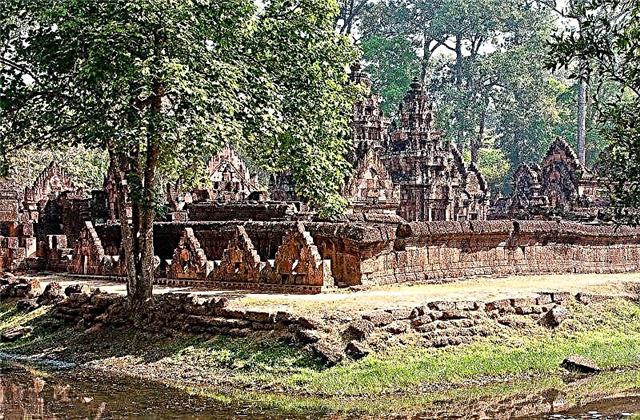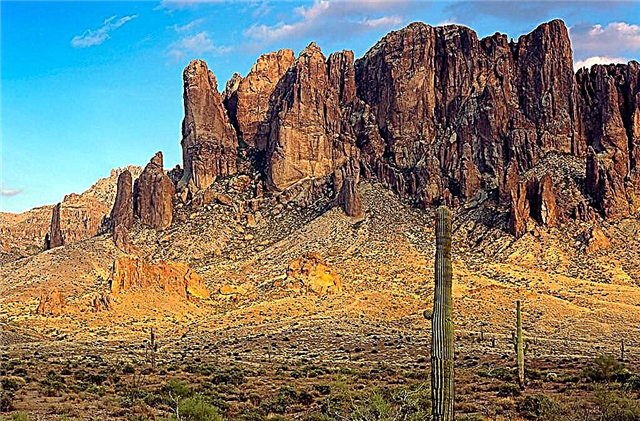Those who think that there are places full of mysteries and mysticism only in science fiction films are very much mistaken. In fact, there are many of them, and the Mountains of Superstition, located in North America, in the state of Arizona, are irrefutable proof of this. Once upon a time, at the dawn of civilization, these harsh, arid territories were turned into fertile lands by Indian tribes through the creation of a perfect irrigation system stretching for hundreds of kilometers.

The canals, made for centuries, still serve the local residents, who are surprised at the high level of development of the Hohokama Indians. But not only for this are these tribes famous in history, who left their lands for the mountains under the onslaught of the Europeans who occupied America in the 16th century. The stay of the Indians in the mountains gave rise to many legends associated with gold deposits.
Legends and myths

The times of the Indians have sunk into oblivion, and legends and myths about countless golden treasures from the 18th century to the present day continue to excite the minds and hearts of Americans. One of the legends, telling about seven cities standing on a gold mine, marked the beginning of a real "gold rush" among the Spaniards who settled in the present mountains of Superstition.

Numerous expeditions were undertaken, the search efforts of which ended in vain. But when a Franciscan monk put forward the idea of finding gold from the Indians, in 1540 the Spanish army of Francis de Coronado raided the mountains, where numerous Indian tribes still lived. However, the army was unable to find anything, while suffering considerable losses of soldiers after the battle with the dexterous and hardy Indians, selflessly fighting for their mountains. Francis took the troops away with nothing, but the Spaniards' claims did not end there.

According to another legend, they took the Indians by cunning, gaining confidence in them and finding out the discovery of mysterious gold mines. For tens of years, the Spaniards mined the precious metal and shipped it to Spain, strictly forbidding the Indians to show the location of the mines to anyone else. One of the legends tells of a sacred grotto in the mountains of Superstition, the entrance of which serves as a gateway to the other world, where the spirits of the Indians live, guarding gold and killing everyone who dares to approach it.
Despite the fateful circumstances, people continued to stubbornly search for the yellow metal. It is known about one adventurer who emigrated from Germany in search of the coveted gold, Jacob Wels. Together with the same fanatical treasure hunter, fellow countryman and namesake in one person, Jacob Weissner, in 1846 he went to the mountains of Arizona, fanned with bad legends. As the rumor of the third legend says, after a long absence, he returned alone, laden with gold, and told about his miraculous salvation from the evil spirits that had killed his companion.

The fourth legend already tells about the gold digger Julia, who learned about the gold mines from Weiss and after his death made an attempt to find them (mines) and get rich. According to rumors, her company managed to do this, as they were guided by the map drawn by the late Weiss. But Julia returned alone empty-handed, because everyone else had been killed. The shocked lady, allegedly, talked about meeting the ghosts of previously dead hunters for gold, who too zealously "guard" him, killing everyone who gets there. According to her, it is impossible to resist them: no bullets can take them.
Julia was deemed crazy, many did not take her chilling narrative seriously, and the extreme hikes continued. And each of them ended tragically: the participants died under strange circumstances, being tortured and decapitated. The mountains overgrown with terrible rumors, covered with bones and drenched in blood, began to be called the mountains of Superstition, and the stream of those wishing to find Jacob's gold does not stop.
The reality of the mountains of Superstition

Most recently, in 2010, when three young Americans from Utah went to the mountains in hopes of finding a mine, they disappeared. The searches, organized by the relatives, did not give any result: only an empty car was found, left at the foot. And only in 2011, by accident, the bodies of the dead seekers were found in one of the gorges. Their death became a mystery, one could only guess what happened: either they themselves fell there through negligence, or someone's unknown force pushed the guys into the gorge.
But it is not only gold miners who are attracted by these mountains; scientists, geologists, researchers are seriously studying the canyons and peaks of the mystical mountains, where they continue to conduct archaeological research, get acquainted with the flora and fauna of these places, and find ancient artifacts. According to them, it is concluded that the first Apache Indians appeared here almost 9000 years ago, tirelessly transforming the wilderness into habitable settlements and cities.

We also recommend:
- National parks of the USA
- Canyonlands National Park, USA
- Yosemite Park in California, USA
- Zion National Park, USA
- Everglades National Park in the USA
- Yellowstone, USA
- Glacier Park in the USA
- Shiprock rock in the USA
- Mesa Verde in the USA
- Mount Rushmore, USA
- Badlands, USA
Mastering and development
The active development of the mountains by tourists began in the late 90s, in connection with which the Museum of the Mountains of Superstition was opened, where exhibits illustrating the history and life of the aborigines of America are presented. Here you can also hear the stories of the guides about the unsuccessful searches for fatal gold in the past centuries, which have become legends.

Now almost all mountain trails are walked by curious tourists, who are interested in exploring the surroundings, the history of which is filled with scary stories. But this no longer scares anyone, but, on the contrary, arouses even greater interest and desire to wander through the mysterious, ghostly Indian settlement cities that still keep many secrets; look into the mysterious depth of canyons and gorges.
The tourist infrastructure is developing: a luxurious well-maintained hotel has been built, a sports complex with golf, tennis and basketball courts has been erected. The mystical mountains are declared a state protected nature reserve, because rare wild animals live here: cougars, brown bears, foxes. In addition, they keep in their depths not only ancient rarities, but, perhaps, indeed, they have innumerable gold reserves.











